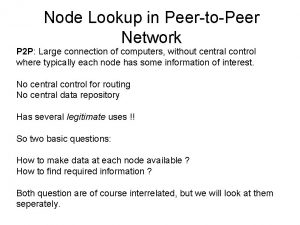Peer Aware Communications PAC Distinctive features for PAC







- Slides: 7

Peer Aware Communications (PAC)

Distinctive features for PAC SG • Peer Aware Communications (PAC) • Or, PAC (Proximity Aware Comm, Social Peer Comm (SPC)? • Any other name? • Key features: Infrastructureless, Fully Distributed, Peerto-peer Communications – – – – Autonomous Association: (without human intervention ) Discovery signaling rate -typically 100 kbps The number of devices in the discovery >100 Data Transmission rate -typically 10 Mbps Group communications: n to m Localization -typically 10 m Unlicensed/lightly licensed bands - below 3 GHz, 60 Ghz Slide 2

Scope • This standard defines the PHY and MAC specifications optimized for proximity peer communications with infrastructureless and fully distributed coordination.

Purpose • The standard provides infrastructureless, fully distributed, peer-to-peer communications: specifically, discovery signaling rate of greater than 100 kbps, the number of devices in the discovery of more than 100 devices, the data transmission rate of greater than 10 Mbps, n-to-m group communications, fast association, and localization.

Need • • In order to support burgeoning social networking and peer-to-peer applications for mobile devices, the awareness of their proximities for desired services is an important feature for future wireless communications. Current communication infrastructure can support those applications but incurs unbearable signaling overhead and communication latency when to support hundreds of devices in the proximity. The fully distributed network without infrastructure is not only useful for crowded places such as mall, stadium, campus, amusement park etc. but also isolated places not supported by infrastructure. It is also useful for emergency situations such as flooding, earthquake, fire, and etc. Potential applications include social networking, advertising, gaming, streaming, urgent notification, device control, p 2 p services, internet of things, and etc. Also, infrastructure-less awareness can relieve the overhead associated with providing user privacy because there are no tracking and no single point of data base otherwise required in the case of the infrastructure based communications.

Use Cases 1. Social network service, gaming, friend finding 2. Advertisement, Kiosk, interactive narration, 3. Consumer Electronics (CE): multi screen services, autonomous device configuration 4. Emergency communications, mobile service extension,

Future Plan • Call for Applications • A Tutorial at 802. 15. WNG in November Plenary meeting, Atlanta • Participants: Samsung, LG, Huawei, ETRI, . . growing • Stay tuned!
 Features of peer to peer network and client server network
Features of peer to peer network and client server network Peer to peer transactional replication
Peer to peer transactional replication Peer intervention program
Peer intervention program Registro peer to peer compilato
Registro peer to peer compilato Annotazioni sulla verifica effettuata peer to peer
Annotazioni sulla verifica effettuata peer to peer Peer to peer chat application in java
Peer to peer chat application in java Programmazione e sviluppo condiviso compilato
Programmazione e sviluppo condiviso compilato Node lookup in peer to peer network
Node lookup in peer to peer network













